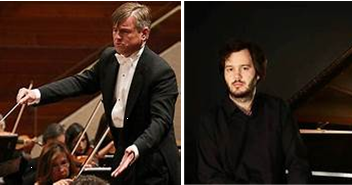A few years ago, a concert program comprising two
works by Beethoven, and one by Schuman would not, for me, have aroused much
interest. That is the value of an abono, a subscription, because a subscription
means that you have opted for an entire season of performances and thus one
goes to whatever is on offer. My wife and I have had a subscription to Alicante’s
ADDA auditorium for several years and so we are now used to attending concerts
that would not usually be in our comfort zone, which is that of twentieth and twenty-first
century music. Last night in ADDA, we received a clear statement of what we have
been missing over the years when we repeatedly tried to edit out what we didn’t “like”.
The concert was by the London Philharmonic Orchestra
under Vladimir Jurowski and featured the violin playing of Vilde Frang. Right,
that has got the star billing out of the way! The concert presented Beethoven’s Coriolan Overture, Robert Schumann’s Violin Concerto,
and then Beethoven’s Symphony No. 5. For
someone who does not normally warm to Beethoven’s
symphonies, I confess that in concert over the last two months I have heard
numbers four, five and seven, and all three in their own way, have proved to be
the highlights of a very rich musical year. My fear of cliché often gets in the
way, but these three performances, and last night’s number five included, have
all been outstanding.
Vladimir Jurowski needs no introduction. He is a
justifiably a world-famous conductor. He is very economical, highly proficient
and a very precise conductor. There are no grand or grandiose gestures, just
content. The way he communicated what he wanted to stress in this performance
of Beethoven’s Fifth Symphony was both subtle and dramatically perfect. His
indication of the syncopations in the final movement, for instance, were both
precise and perfectly judged. In the central movements, Beethoven’s
memory of wind bands in the street were clear, but the context was always
architectural, with nothing being played for momentary effect. The pace of the
first movement was fast and this “knock of fate on the door” was truly
frightening. Again, I am tempted to describe the playing and the conducting as
perfect.
The Coriolan Overture in its own way a masterpiece.
Here Beethoven is trying to give us a complete Shakespeare play in five
minutes. The ending, where treason results in public disgrace, is telling.
The Violin Concerto of Robert Schumann is potentially
at least a problematic work. It is a late work, perhaps conceived when Robert
Schumann was not fully in control of his own mind. But how many of us care when
the result is what we heard? Vilde Frang’s playing
made sense of this rather rambling score and the orchestral accompaniment was
always sympathetic to her substantial dynamic. The sound from her Guarneri was
something to behold. She did play an encore, which I believe was Montanari’s Giga
Senza Basso.
I intend to repeat the subscription for another year at least!













.jpg)






